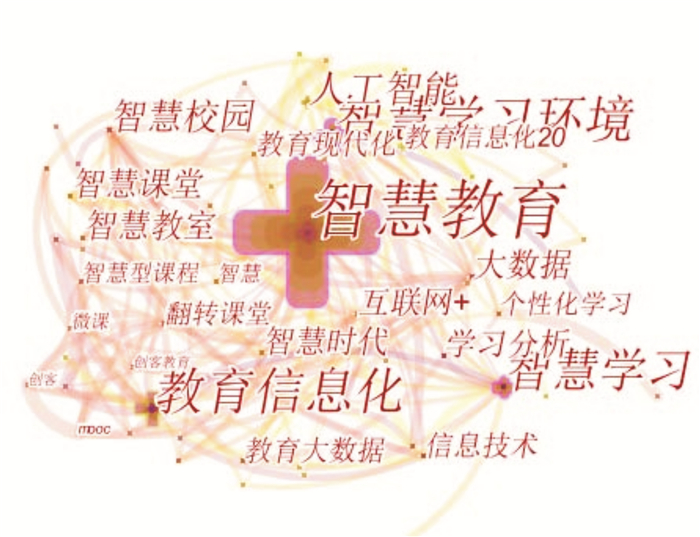-
随着人工智能时代的来临,传统教育早已不能满足人们的需求,信息技术与教育相结合成为社会变革的新生力量,教育担负着人工智能时代培养人才的重任。2017年,国务院印发的《新一代人工智能发展规划》明确提出“用智能技术加快推动人才培养模式、教学方法改革,构建包含智能学习、交互式学习的新型教育体系。开展智能校园建设,推动人工智能在教学、管理、资源建设等全流程应用”[1],这标志着我国智慧教育时代正式来临。所谓“智慧教育”,是教育信息化的产物,是依托物联网、云计算、无线通信等新一代信息技术打造的物联化、智能化、感知化、泛在化的新型教育生态系统。2018年,教育部印发的《教育信息化2.0行动计划》首次提到“智慧教育”。“智慧教育”不仅第一次被纳入国家层面的规划文件中,而且被列入教育信息化2.0发展的“八大行动”里。这表明,智慧教育已正式纳入国家教育信息化战略体系[2]。
智慧教育已经成为人工智能时代的研究热点。本文运用陈超美博士开发的CiteSpaceⅤ软件对数据进行可视化分析,采用文献法、比较法和词频分析法,绘制出以关键词为主要内容的科学知识图谱,进而对国内外智慧教育研究热点进行比较分析。通过分析,了解国内外智慧教育发展的最新形势,为进一步做好相关研究工作提供参考和借鉴。
全文HTML
-
以中国知网(CNKI)为检索数据库,以“智慧教育”为主题词进行检索,论文检索时间设定为2009年1月1日-2018年12月31日。通过初步筛选,将会议通知、广告等与主题关联不大的文章删除,最终纳入分析样本的文献数为294篇。将其以Refworks格式导出保存,每一条数据均包含文献名、作者、关键词、摘要等题录信息,最后再将数据转化为国内研究的数据源。将数据导入软件,其他相关节点设置好,运行节点选择“keyword”(关键词),得到如图 1所示的关键词共现图谱和表 1所示的高频关键词。
-
关于智慧教育的起源,国内尚无统一定论。部分学者认为,智慧教育源于美国IBM公司提出的“智慧地球”(smarter planet)的概念。所谓“智慧地球”,是指以信息技术为支撑所构建的新世界,基于这一理念催生出许多新的概念,比如智慧城市、智慧交通、智慧医疗以及智慧教育等[3]。另一部分学者则提出不同观点。如江苏师范大学的陈琳认为,IBM公司倡导的“智慧”与智慧教育大相径庭。前者的核心是感知、联通、智能化,并未超出教育信息化的层次和范畴。但是教育是具有前沿性和先导性的,智慧教育的含义应该代表了新的发展方向,因此,智慧教育源于“智慧地球”的说法是一种错误、扭曲的观点[4]。她认为,智慧教育的源头可以追溯到20世纪末,我国著名科学家钱学森先生提出的“大成智慧”教育理论。钱学森基于以微电子信息技术革命为先导的高科技群体的飞速发展,提出“大成智慧”是沉浸在广阔的信息空间里所形成的网络智慧,是一种新的世界观、方法论,新型的思维方式和人-机结合的思维体系。他站在时代的前沿,其观点比IBM的“智慧地球”说早了10年[5]。学者祝智庭概括性地将两种观点结合在一起,认为钱学森先生的“大成智慧学”对信息化时代教育的发展起到了关键性的引导作用,而美国IBM公司的“智慧地球”概念则推动着智慧教育快速发展[6]。
-
表 1中的“智慧学习”“翻转课堂”“微课”“个性化学习”“智慧课程”等高频关键词,反映了传统教学模式与智慧教育教学模式的本质区别。前者依赖于传统课堂,以教师讲授为主,忽视了学生的个性发展,导致学生缺乏思辨能力、创新能力等;后者将教育信息技术引入课堂中,首先改变了学生在教学中的地位,以学生为主导的教学模式极大地激发了学生的求知欲,可促进学生自动、自主、自觉地探索和解决学习问题,其次是采用了翻转课堂、微课等线上线下相结合的混合型教学模式,这一方面有利于学生的灵活学习,另一方面也有助于教师的因材施教。学者黄荣怀分别从宏观、中观、微观层面说明了传统教学模式的转变,认为以技术为导向的教与学必然催生新型教学模式[7]。但是如何有效融合技术与教学,而不是单纯地以技术为导向,学者们对此的关注则不够。另外,由于智慧教育的教学模式依赖于智能设备和技术,如果学校的硬件设施不完备、教师信息素养不足,便无从实施。因此,如何深化智慧教育视域下教学模式的研究,是我国学者应积极面对的问题。
-
图 1、表 1中的“智慧学习环境”“智慧校园”“智慧课堂”“智慧教室”等高频关键词代表了形式多样的智慧学习空间。智慧学习空间是教育信息化的衍生物,主要指支持多种范式并存的学习场域,它通过借助智能技术,连接现实和虚拟空间,帮助教育者了解学习者的学习差异,提供满足多方面学习者个性化需要的学习资源[8]。黄荣怀从目标和特征的角度,提出融合物理环境和虚拟环境,可以更有效地感知学习情境、识别学习者特征、提供资源和互动工具、自动记录学习过程和评测结果,目的是为了支持学习者个性化学习需要的实现,构建促进有效学习的学习空间[9]。祝智庭从功能的角度进行探索,提出智慧学习空间的十大功能:位置感知、情境感知、社会感知、互操作性、无缝连接、适应性、泛在性、全程记录、自然交互、深度参与[10]。学习空间的重构是实现教与学变革的基础,旨在走出传统教室,探索多范式学习场域。
-
“大数据”“人工智能”“信息技术”“增强现实”等关键词在表 1中也分别占据了一席之地,由此可见,我国学者对智慧教育的技术和体系架构也有一定的研究。物联网、云计算、大数据、人工智能是智慧教育的核心技术支撑,如何有效地应用技术发展智慧教育,是我国目前需要关注的研究重点。在体系架构方面,杨现民提出了“一个中心、两类环境、三个内容库、四种技术、五类门户、六种业务”的观点。他认为,物联网、云计算、大数据和泛在网络四种技术快速渗透到教育领域,改变了教育的生态环境和运作模式[11]。教育部也提出加快构建智能学习体系,包括建设5G网络技术、建设大容量智能教学资源、创建智能学习空间(在线智能教室、智能实验室、虚拟工厂等),形成泛在化、智能化学习体系[2]。来自CNKI的数据显示,关于技术层面的文献数量较多,但大多集中于理论研究,对于物联网、大数据和云计算等核心技术的应用研究还不够成熟。而有效应用智能技术,推进教育与技术的深度融合,应是智慧教育发展的关键。
一. 关于智慧教育起源的纷争
二. 关于智慧教育教学模式的认识
三. 关于智慧学习空间的表达
四. 关于智慧教育的支撑和体系
-
以Web of Science(WOS)为检索数据库,以“smart education”为主题词进行检索,对“smart learning/learning environment”等主题词进行二次精炼,剔除非教育类文献,文献类型选择论文、综述和期刊评论,时间跨度与国内一致,共得到209篇可用文献。软件节点选择“keyword”(关键词),以纯文本的格式导出保存,得到如图 2所示的关键词共现图谱和表 2所示的高频关键词。
-
美国IBM提出智慧地球的概念使智慧教育兴起于全球。IBM提出21世纪教育具有五大特征:学生的技术沉浸、个性化的学习路径、知识技能、资源的全球整合以及教育与经济的紧密结合[12],并以此为基础构建了智慧教育框架。框架的核心是为学生提供个性化的学习体验。智慧教育框架的特点可分为三个层面:一是以加强学习者个性化体验、提升教育管理质量与效率为核心,突出大数据、云计算、物联网等先进技术的应用;二是化整为零,结合教育实际需求制定若干更加具体的解决方案;三是将数据视为宝贵资源,注重教育大数据的深度分析与应用[13]。韩国作为教育信息化程度最高的国家之一,智慧教育的发展已经位居世界前列。韩国学者Park针对智慧教育的内涵,将其特征划分为了五个层面——分别由智慧教育中“智慧”的英文单词smart的各字母代表,如表 3所示[14]。韩国的智慧教育旨在创设以学生经验为中心的问题情境,激发学生自主学习的动机,为学生提供免费开放的教育资源,鼓励学生进行自适应学习[14]。
通过以上分析可知,无论国内还是国外,智慧教育的核心目标都是促进学生个性化发展,培养适合信息时代的智慧人才。但国外智慧教育的研究起步早于国内,相关理论研究更为成熟,目标维度划分更为具体。
-
图 2和表 2中的关键词deep learning(深度学习)、e-learning(在线学习)、smart learning(智慧学习)等,反映出国外智慧教育视域下的教学模式。其中,深度学习是智慧教育持续发展的关键支撑,它提供了先进的分析工具和分析方法。我国教育部发布的《高等学校人工智能创新行动计划》和《新一代人工智能发展规划》,均强调了深度学习在教育人工智能(E-AI)中的重要性。所谓“深度学习”,是指在理解的基础上,学习者批判性地学习新思想和新知识,并将它们与原有的认知结构相融合,将众多思想相互关联,将已有的知识迁移到新情境中,做出决策并解决问题。教育信息化时代下,技术当先,深度学习成为破解学生智能学习难题的关键因素。Hatcher对深度学习的应用和机制进行了全面的评估,详细论述了深度学习在人工智能时代已被应用于各个领域,强调深度学习可加速实现物联网广泛应用于智能设备,优化移动学习。此外,基于物联网和CPS(信息物理系统)的分布式深度学习必须在边缘计算范式下运行,以便更好地服务于受限设备。Hatcher还提供了几个典型的深度学习平台,以为深度学习实践者提供参考,如Tensor Flow、DL4J、Theano、Torch等。但是深度学习在网络操作、管理、设计和控制方面的应用还未被涉及,有待学者进一步深入研究[15]。
-
学习环境主要包括物理学习环境、技术学习环境、情感学习环境。智慧教育的物理学习环境主要有“smart campus”(智慧校园)、“smart classroom”(智慧教室)、“smart city”(智慧城市)等。表 2中排名第一的关键词即“智慧校园”。通过阅读相关文献发现,智慧校园并不是由技术堆砌而成的,它不同于数字校园将重心放在技术层面,而是一种技术增强型的学习环境,集成智能学习系统、情境感知和智能交互,是将大数据和云计算等新兴技术有效整合之后的产物。技术学习环境有“internet of thing”(物联网)、“algorithm”(算法)、“recognition”(识别)、“big data”(大数据)、“IoT”(物联网)等。技术类的词在表 2中有十个之多,占比达到三分之一。由此可见,国外对智慧教育的研究集中在技术支撑上,如分析框架、学习平台、理论模型等都依托于现代教育技术。情感学习环境主要由三部分组成:心理因素、人际交互、策略,其目的在于激发学生的学习动机和兴趣,使其获得更好的学习效果,如表 2中的关键词“recognition”(识别)。情感识别技术反映出国外对智慧教育的研究已经进入后续阶段,既关注学习者的情感体验,又重视学习者的兴趣培养和动机激发。如Nurjaman提出,有效的智慧学习包含三个方面的内容:心理系统、学习行为、学习成果,其中心理系统的关键组成部分是学习动机,因此智慧学习中的核心即是激发学生学习动机,促进学生产生学习行为,实现高效学习[16]。IIkyu、Ahmad、YeLin Kim均在他们的研究中提到情感识别、学生兴趣等关键词。他们的共同点都在于采用情感感知技术判断学生的兴趣所在,从而有效激发学生的学习动机,提高学生的学习效率[17-18]。
-
国内与国外智慧教育研究的最大区别在于,国外研究的高频关键词中出现了智慧教育的学习主体“student”(学生)以及“performance”(效能)、“energy efficiency”(能力效率)等关键词。信息时代下的学生被称为“数字土著”(digital native)或者“网络一代”(net generation),他们的学习风格、认知方式、情感模式等都已经发生了根本性转变,因此培养高智能和富有创造性的人才成为时代所需。阅读相关文献发现,国外为了顺应和满足“数字土著”的发展及需要,正在逐渐转变教学方式,尤其是评价模式,拟通过开发智能评估软件,更加精确地评测学生的学习体验和成效,重视学生的接受度和理解度。韩国学者李郑苏(Jeong-Sook Lee)和金成万(Sung-Wan Kim)提出,开发教育软件(eduactional apps)评估学校的教与学,不仅要了解教师是否有适当的技术应用,更要了解学生的学习效果和学习反馈,判断该技术是否有利于学生学习。他们将评估学生学习效果的指标分为四个维度,分别是教学、屏幕设计、技术以及经济与道德。通过评估,有助于实现智慧教育自我导向、激发学习动机、丰富学习资源、实施自适应学习和嵌入式教学的目标,也有助于学生更好地自我调适、自定步调,最终达到最佳学习效果[19]。
一. 关于智慧教育理论基础的认识
二. 关于智慧教育教学模式的探讨
三. 关于智慧学习环境的构建
四. 关于智慧教育学习主体的体验反馈
-
我国的教育信息化战略始于2010年颁布的《国家中长期教育改革和发展规划纲要(2010-2020年)》。“规划刚要”明确提出要加快教育信息基础设施建设,加强优质教育资源开发与应用,构建国家教育管理信息系统,并首次强调“信息技术对教育发展具有革命性影响”。2012年印发的《教育信息化十年发展规划(2011-2020年)》提出,建设人人可享有优质化信息资源的学习型环境和构建以信息技术为支撑的学习型社会,致力于信息技术与教育的融合,大力提升教育信息化水平。2016年发布的《教育信息化“十三五”规划》进一步明确了2020年教育信息化发展目标,要基本形成具有国际先进水平、信息技术与教育融合创新发展的中国特色教育信息化发展之路。2018年教育部出台的《教育信息化2.0行动计划》综合以上文件的发展目标与任务安排,提出实施数字资源服务普及行动、网络学习空间覆盖行动……智慧教育创新发展行动、信息素养全面提升行动等八大行动。教育信息化的发展可谓如火如荼,智慧教育作为智能时代的重点战略任务,理应成为教育改革的重要议题。
目前,我国的智慧教育尚处在初步建设阶段。通过对国内外智慧教育研究文献的数据进行知识图谱可视化分析,发现在理论层面,国内外均未形成系统的理论体系;在教学模式层面,国内重在发展混合式教学模式,国外侧重于深度学习理论及其应用;在学习环境层面,国内重视学习空间的重构,国外重视多维度环境的应用;在学习主体方面,国内目前更加注重技术开发,国外已进入后续研究,关注学生的学习体验与反馈。由此,笔者拟结合国内外智慧教育研究热点的比较分析以及我国教育信息化的政策指导,就我国智慧教育的研究及未来发展提出以下建议:
-
智慧教育在我国作为一种新兴的教育形态,相应的理论基础尚不成熟,关于智慧教育的缘起尚存争议。当前,国内智慧教育的理论研究主要集中在基本内涵、特征等层面以及由此衍生出的智慧学习、智慧教学模式、智慧学习环境等方面。加德纳多元智力理论、信息加工理论以及贯一性设计等相关理论贯穿在相应的论文或研究中,但是均未形成系统的智慧教育理论体系。国外虽然相关的理论研究和认识也较为鲜见,但是韩国、美国等学者皆对智慧教育的内涵进行了多维度划分和探讨,关于教学模式、学习环境等智慧教育的理论探讨都已延伸至实践层面。我国需要借鉴国外的实践研究,不能仅停留于纸上谈兵。智慧教育的实践是检验相关理论的唯一标准,应充分发挥试点学校或地区的作用,实现以点带面、逐步推开。此外,还应加强政府、地区、学校以及相关企业间的通力配合,打造智慧教育示范区,建立智慧教育生态系统,进一步完善智慧教育理论体系。
-
重构学习空间是智慧教育的关键一环。国内外从“智慧学习环境”“智慧课堂”“智慧校园”“智慧课堂”等角度对智慧学习空间进行了探讨。国内主要从功能、目标等角度研究智慧学习空间,提出构建兼具感知性、无缝连接、自适应性等特征的智慧学习环境。目前我国的智慧教育仍处于起步阶段,智慧学习空间的建设仍需要政府的大力支持以及人才和技术的强力支撑。国外则以技术为落脚点,开发多种智能设备,并将之应用于学校教学,从实践层面研究学习空间,但是相关技术研究有待深化。笔者认为,为了进一步优化学习场域,为学生提供更加科学合理的学习环境,研究者在重构学习空间时应考虑以下两个方面。一是打造立体化的学习空间。传统学习空间与智慧学习空间的区别在于前者是指实体空间,即将学生和教师置于教室进行班级授课,后者则是旨在建立更加立体化的学习空间,通过实体空间与虚拟空间的有效结合,采用线上线下互通的教学方式,打破学生传统学习的藩篱,构建虚实结合的智慧学习场域。二是建立多样化的学习空间。重构智慧学习空间的目的在于满足学生的差异化、个性化发展需要,探索智慧教育学习空间,开发多样化学习形式,激发学习者的学习兴趣,使学习者积极参与到学习之中。
-
国内外智慧教育的研究重点均包括教学模式,推动教与学方式的变革是各国智慧教育的核心目标之一。我国顺应这一发展趋势,积极探索新型教学模式,以优化升级国内教育教学。但是目前,国内智慧教育的软硬件设施都还不够完善。相比之下,国外对于智慧教学模式的研究更加成熟。如韩国通过电子教科书实现技术与学习的深度融合,改变了以传统教科书为主导的单一教学取向。我国可以以此为借鉴,融技术与学习为一体,发展混合式动态智慧教学模式。目前的MOOCs、翻转课堂、微课等,基本实现了基于技术的教学模式变革,但为了进一步融合智能技术,探索深度学习,仍需开发新的教学模式。笔者认为可从以下两个方面着手。一是线上线下融合设计。线上为学生提供不同的教学内容,包括电子课本、在线作业等,以满足学生的多样化学习需求;线下则利用集体授课的形式,通过传统课堂,促进师生间、学生间的交流与合作。二是课内课外贯穿设计。一方面将教学问题融于真实情境中,帮助学习者建立与真实世界的联系,促进学习者的深度学习;另一方面,减少学习的无趣感,激发学生的学习兴趣,进一步满足学生的个性化发展需要。
-
智慧教育的教学手段虽然是以技术为支撑,但其主体依旧是学习者。在探索智慧教育的过程中,不能过于强调以技术为主导,而是应该在结合技术的基础上以人为中心,关注学习者的学习兴趣和情感,重视情感体验,贯彻技术为教师教学和学生学习服务的思想。通过比较研究,无论是国内还是国外,智慧教育发展到现阶段,都在探索以学生为中心的智慧教育发展模式。国内目前处于初步探索阶段,关于学习主体情感体验的研究还只是贯穿于其他主题的研究之中,或仅是停留于对情感感知技术的探讨。国外已经进入到相对成熟的后续研究阶段,相关的技术已经开发出来并应用于实践当中,如通过情感感知技术,挖掘学生的兴趣所在,从而激发学生的学习动机,使之更有效地进行学习。我国目前需要明确智能技术的开发最终是作用于人,因此技术与育人必须并重,应充分贯彻以学生为主体的教学观,进一步开发情感感知技术,为学习主体打造更科学、更人性化的智慧教育。




 下载:
下载:
